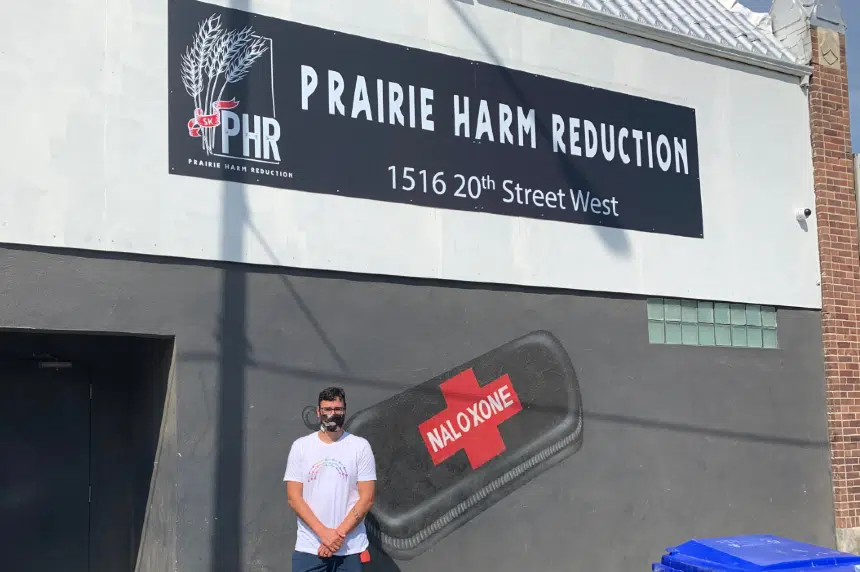The biggest request by clients at Prairie Harm Reduction (PHR) has been fulfilled.
Since June 21, the safe consumption site has been operating through the evenings. The soft opening gave executive director Jason Mercredi time to prepare, but the expansion to hours from 10 a.m. to 10:30 p.m. was formally announced Monday.
“It’s nice to be open in the evenings. We’ve been able to stop a number of overdoses from happening — in and around the building. Also, they’ll have a place to go in the evening,” he said Monday before giving an example of one recent incident at the PHR site.
Mercredi said an individual had been bear-sprayed several blocks away from PHR. The individual ran to PHR, noting they felt safe at the facility.
“We were able to help them (and) make sure they didn’t lose their vision. (We did) some follow up afterwards and connected them with other services … Being open in the evenings is a whole different ballgame,” he continued.
During the June 21 to July 2 expansion of hours, the safe consumption site was open, but the drop-in centre was not. Mercredi said those additional services are now available at any time during those 12.5-hour days.
He also reiterated the expansion into the evening hours was the largest ask by clients since the safe consumption site originally opened last October.
“We’re pretty happy with the way it went,” he said. “Thanks to the fundraising, we were able to hire a paramedic, a couple support workers (and) we gave somebody their first job they’ve ever gotten. We’re pretty pumped on that.
“(Clients) are liking it … We’re anticipating a winter that (overdoses are) going to increase dramatically, just because there’s not a lot of places to go.”
From Jan. 1 to June 2, 46 confirmed overdose deaths occurred in Saskatchewan. Another 125 are still suspected, with June’s totals expected in the coming days.
Mercredi said as the heat increases so does the risk of overdose. Yet he said the winters are “brutal” for the vulnerable community.
“This winter, we’re quite worried,” he said. “At least we’re going to be able to keep them safe, and warm, up until 10:30 (p.m.).”
The expansion in hours was thanks to a massive April fundraiser. It was one that PHR didn’t run on its own, but following the provincial government’s decision not to fund the safe consumption site, the private sector stood up.
More than $180,000 was fundraised by 62 businesses, all in that single month.
How long will that money last? Mercredi had the answer Monday.
“We’re probably good for the year, but we’re starting to buy better medical equipment,” he said.
“On top of that, running these facilities is not cheap. Our air exchange kicks out a lot of power. It’s good that it does. It keeps everybody safe in the community and the building … We stretch the dollar as much as we can.”
Story continues below photo

Prairie Harm Reduction executive director Jason Mercredi stands in front of the safe consumption site on Aug. 19, 2020. (Brady Lang/650 CKOM)
‘Everybody but government realizes they should be paying for this’
Mercredi said PHR receives $320,000 from the Ministry of Health to run its outreach services and naloxone trainers. An additional $670,000 is given for its Family Support Program, which runs off-site, near PHR at an apartment building.
No money is given to PHR for its safe consumption site, said Mercredi. That’s something he feels needs to change.
“We need government funding because it’s not fair to put this on the backs of community members. d’Lish by tish shouldn’t be having to sell soup to stop people from dying,” he said.
“It seems like everybody but government realizes they should be paying for this.”
On June 28, Saskatchewan’s doctors asked the government to fund the safe consumption site for 24-hour-a-day access. The ask, endorsed by the Saskatchewan Medical Association’s Representative Assembly, is for funding all safe consumption sites.
“We recognize we have an addiction and overdose crisis on our hands. The government also seems to recognize that the number of deaths from overdoses is astronomical. We should be using every tool at our disposal to try to decrease the loss of life,” Saskatoon’s Dr. Carla Holinaty stated in its release.
“We can put a ton of money into recovery and detox and things like that, but we lose many people to overdose deaths before they even have a chance to enter into that program.”
Additionally, Saskatoon Community Clinic doctors challenged all Saskatchewan doctors to contribute $1,000 to PHR, or whatever they’re comfortable donating.
Mercredi said it was a good feeling to be backed by the medical association.
“Especially because it was internally. They did it themselves. We didn’t lobby or anything. They knew it was the right thing to do. They see the benefit of it. We’re pretty humbled,” he said. “I think COVID has taught us one thing: They know what they’re doing … We’re hopeful Scott Moe’s going to be listening this next go around.”
Mercredi said there haven’t been any talks between PHR and the province in recent months.
“Everybody and their dog seems to know … that this needs to happen. The government should be funding it,” Mercredi said.
“Right now, it’s just us trying to respond as best we can.”







